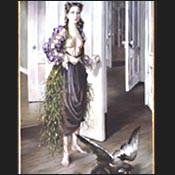
He was in love with love in a world that believes in prostitution, said Marcel Duchamp of the Surrealist leader, André Breton. Something similar could be said of most of the Surrealists. Their idea of love had little in common, of course, with the sugary and restrictive sentiments of bourgeois society. Surrealist passion, freed from scruple and calculation, would liberate desire and reveal the half-seen worlds that lay behind mundane reality. It would unlock a magical place of wit and ardor where Venus could be both a delightful muse and a magnificent monster. It was this pure world of the imagination, not the prostituted world of most daily life, that represented essential “reality” to the Surrealists. In the large survey that opened last week at the Metropolitan Museum of Art, Surrealism: Desire Unbound, the curators have particularly emphasized the erotic charge of the style. It is a poignant emphasis – for the mood of love has changed since the heyday of Surrealism.
The show at the Met is an adaptation – by William S. Lieberman and Anne L. Strauss – of an exhibit organized by the Tate Modern in London. Though smaller than the London show, it is still large enough. It includes more than 300 works of painting, sculpture, and photography, and various books, papers, and Surrealist bric-a-brac. All the best-known proponents of the style are represented, among them Breton, Masson, De Chirico, Bellmer, Dalí, and Man Ray. (None is presented in depth, as this is a survey.) Important artists influenced by Surrealist ideas but not necessarily Surrealists with a capital S are also represented, notably Picasso, Miró, Giacometti, and Gorky. Much of the show’s interest comes from the chance to see less-familiar works. The sculptor Maria is not well known today, for example, but her work The Impossible III – which resembles two lovers transformed into a hungry Venus flytrap – is a vision of devouring desire that you will not soon forget. Lieberman is a curator who is especially good at remembering overlooked art and making revealing comparisons. Since Surrealism itself relished the surprising and perverse juxtaposition, “Desire Unbound” is full of artistic and curatorial play.
Still, the exhibit confirms once more that “official” Surrealist art has not worn especially well. Surrealism was a highly mannered café style that often depended upon the merely clever, which could quickly grow tiresome. It led the ordinary and amateurish to fancy themselves geniuses, since it placed the individual imagination over tradition, and spontaneity over schooling. Often, there was a home-movie sameness to its erotic dreaming – a period look – that belied the originality the style cultivated. And some of the painting, in particular, was just god-awful. Yet the importance of the movement cannot be overestimated. In the twenties and thirties, it provided the essential spark to a number of great artists on the margins of the official style. It seemed to give them the courage to be themselves. Without the liberating air of Surrealism, for example, Pollock would not have become Pollock. And Miró, Giacometti, and Gorky would probably never have found their individual ways. In even the minor or failed efforts of the period, moreover, there is something gallant – the spirit of explorers out looking for new continents.
In the first half of the twentieth century, it was not only the Surrealists who believed that desire unbound would renew the world; many people of that time fell in love with love. Think of the heat that D. H. Lawrence brought to the novel. So strongly did the Surrealists believe in the scale and power of love (including its terrors) that they now appear almost innocent to our more jaded time. All those snapshots of Surrealist couples in which the woman has opened her blouse – as if that alone meant freedom and was, besides, the most casually and stylishly daring thing to do in the world – seem fetchingly naïve. Even the pornography has a certain purity. In their unconstrained new world of desire, there was to be nothing small or pinched. The Surrealists’ prose was unashamedly purple. They could talk for hours about a mythological creature called Woman. A Man Ray nude appeared to be more than a nude – it was Yearning herself. Even the comedy was enlarging. Duchamp’s Female Fig-leaf both revealed and concealed. In those days, sex still had secrets. Love still seemed young.
Surrealism: Desire Unbound
At the Metropolitan Museum of Art; through 5/12.